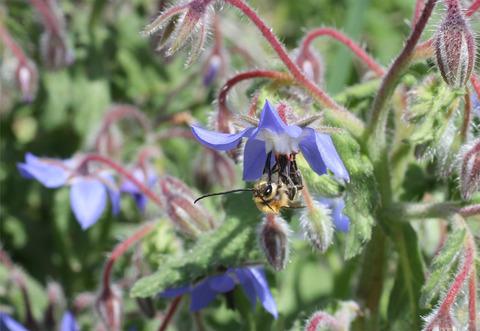当前位置:
X-MOL 学术
›
J. Appl. Ecol.
›
论文详情
Our official English website, www.x-mol.net, welcomes your
feedback! (Note: you will need to create a separate account there.)
The relative importance of green infrastructure as refuge habitat for pollinators increases with local land‐use intensity
Journal of Applied Ecology ( IF 5.0 ) Pub Date : 2020-05-28 , DOI: 10.1111/1365-2664.13658 Pengyao Li 1, 2 , David Kleijn 1 , Isabelle Badenhausser 3, 4, 5 , Carlos Zaragoza‐Trello 6 , Nicolas Gross 7 , Ivo Raemakers 8 , Jeroen Scheper 1
Journal of Applied Ecology ( IF 5.0 ) Pub Date : 2020-05-28 , DOI: 10.1111/1365-2664.13658 Pengyao Li 1, 2 , David Kleijn 1 , Isabelle Badenhausser 3, 4, 5 , Carlos Zaragoza‐Trello 6 , Nicolas Gross 7 , Ivo Raemakers 8 , Jeroen Scheper 1
Affiliation

|
Agricultural expansion and intensification have resulted in strong declines in farmland biodiversity across Europe. In many intensively farmed landscapes, linear landscape elements such as field boundaries, road verges and ditch banks are the main remaining green infrastructures providing refuge for biodiversity, and as such play a pivotal role in agri-environmental policies aiming at mitigating biodiversity loss. Yet, while we have a fairly good understanding of how agricultural intensification influences biodiversity on farmland, little is known about whether and how local land-use intensity affects biodiversity in nearby linear landscape elements and how this affects their role as biodiversity refuge. Focussing on pollinating insects, we examined the effects of local land-use intensity on biodiversity in agricultural fields and adjacent green infrastructures. In an intensively farmed area in south-western France, we selected 23 agricultural grasslands and nearby field boundaries along a gradient in grassland cutting frequency which acted as a proxy for land-use intensity. We analysed how grassland cutting frequency affects species richness, abundance and community composition of wild bees and hoverflies in the grasslands and neighbouring field boundaries, and whether these effects differ across habitat types and species groups. Grassland cutting frequency negatively affected pollinator species richness and abundance in the grasslands, whereas pollinators in the neighbouring field boundaries were unaffected. These responses reflected the effects of cutting frequency on floral resources, with flower cover and richness decreasing in grasslands but not in field boundaries. As a result, the proportion of the local pollinator community supported by field boundaries increased with the increasing cutting frequency of the adjacent grassland. Common and rare pollinator species generally showed similar responses. Furthermore, communities of plants and pollinators in field boundaries next to intensively farmed grasslands were fairly similar to those next to extensively farmed ones. Synthesis and applications. Our results suggest that, as nearby land use intensifies, flower-rich field boundaries become increasingly important as pollinator refuge habitats. Conserving field boundaries and other green infrastructures, and maintaining or enhancing their quality, therefore constitute important tools to conserve and promote pollinators in intensively farmed landscapes.
中文翻译:

绿色基础设施作为传粉者避难栖息地的相对重要性随着当地土地利用强度的增加而增加
农业扩张和集约化导致整个欧洲农田生物多样性急剧下降。在许多集约化农业景观中,田间边界、道路边缘和沟渠等线性景观元素是主要的剩余绿色基础设施,为生物多样性提供庇护,因此在旨在减轻生物多样性丧失的农业环境政策中发挥着关键作用。然而,虽然我们对农业集约化如何影响农田的生物多样性有相当好的了解,但我们对当地土地利用强度是否以及如何影响附近线性景观元素的生物多样性以及这如何影响它们作为生物多样性避难所的作用知之甚少。专注于授粉昆虫,我们研究了当地土地利用强度对农田和邻近绿色基础设施生物多样性的影响。在法国西南部的一个集约化养殖区,我们沿着草地切割频率的梯度选择了 23 个农业草地和附近的田野边界,作为土地利用强度的代理。我们分析了草原砍伐频率如何影响草原和邻近田间野蜂和食蚜蝇的物种丰富度、丰度和群落组成,以及这些影响是否因栖息地类型和物种群而异。草地切割频率对草地传粉媒介物种的丰富度和丰度产生负面影响,而邻近田间边界的传粉媒介不受影响。这些响应反映了扦插频率对花卉资源的影响,草地的花卉覆盖度和丰富度下降,但田界没有。因此,随着邻近草地采伐频率的增加,由田界支持的当地传粉媒介群落的比例增加。常见和稀有授粉物种通常表现出相似的反应。此外,集约化养殖草地附近田间边界内的植物群落和传粉媒介群落与集约化养殖草地附近的群落非常相似。合成与应用。我们的研究结果表明,随着附近土地利用的加剧,鲜花盛开的田野边界作为传粉媒介避难所栖息地变得越来越重要。保护场地边界和其他绿色基础设施,并保持或提高其质量,
更新日期:2020-05-28
中文翻译:

绿色基础设施作为传粉者避难栖息地的相对重要性随着当地土地利用强度的增加而增加
农业扩张和集约化导致整个欧洲农田生物多样性急剧下降。在许多集约化农业景观中,田间边界、道路边缘和沟渠等线性景观元素是主要的剩余绿色基础设施,为生物多样性提供庇护,因此在旨在减轻生物多样性丧失的农业环境政策中发挥着关键作用。然而,虽然我们对农业集约化如何影响农田的生物多样性有相当好的了解,但我们对当地土地利用强度是否以及如何影响附近线性景观元素的生物多样性以及这如何影响它们作为生物多样性避难所的作用知之甚少。专注于授粉昆虫,我们研究了当地土地利用强度对农田和邻近绿色基础设施生物多样性的影响。在法国西南部的一个集约化养殖区,我们沿着草地切割频率的梯度选择了 23 个农业草地和附近的田野边界,作为土地利用强度的代理。我们分析了草原砍伐频率如何影响草原和邻近田间野蜂和食蚜蝇的物种丰富度、丰度和群落组成,以及这些影响是否因栖息地类型和物种群而异。草地切割频率对草地传粉媒介物种的丰富度和丰度产生负面影响,而邻近田间边界的传粉媒介不受影响。这些响应反映了扦插频率对花卉资源的影响,草地的花卉覆盖度和丰富度下降,但田界没有。因此,随着邻近草地采伐频率的增加,由田界支持的当地传粉媒介群落的比例增加。常见和稀有授粉物种通常表现出相似的反应。此外,集约化养殖草地附近田间边界内的植物群落和传粉媒介群落与集约化养殖草地附近的群落非常相似。合成与应用。我们的研究结果表明,随着附近土地利用的加剧,鲜花盛开的田野边界作为传粉媒介避难所栖息地变得越来越重要。保护场地边界和其他绿色基础设施,并保持或提高其质量,











































 京公网安备 11010802027423号
京公网安备 11010802027423号